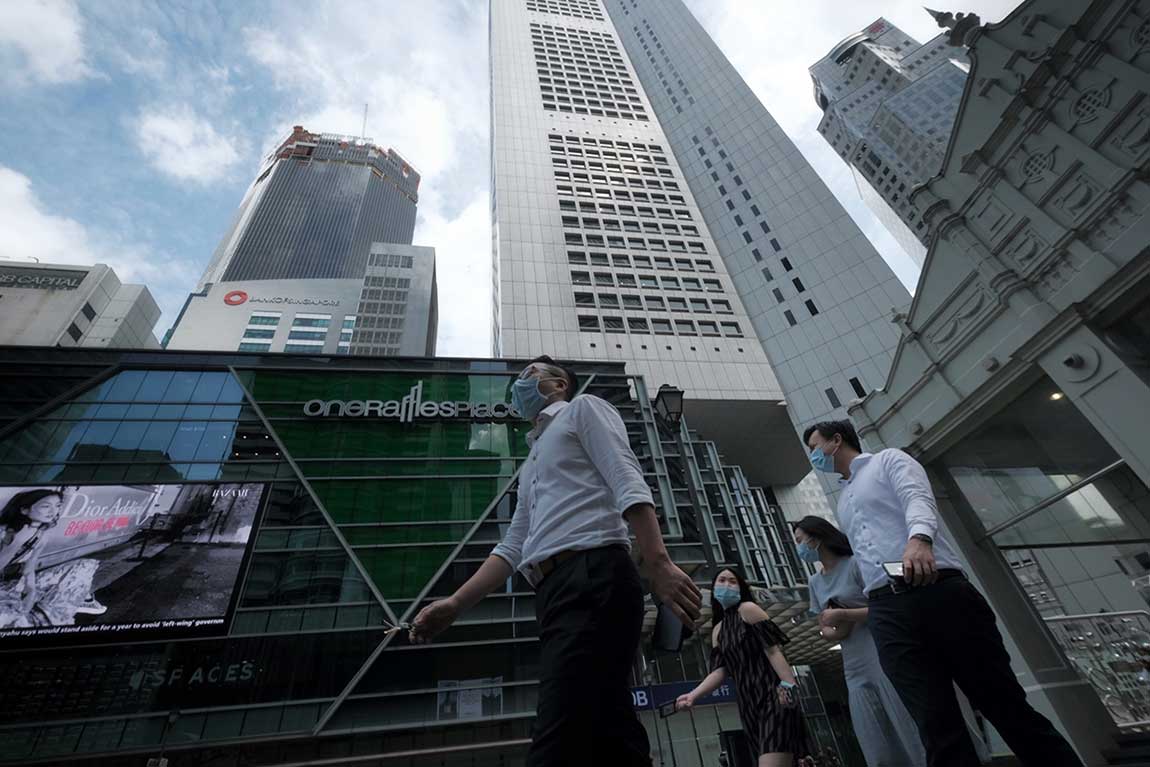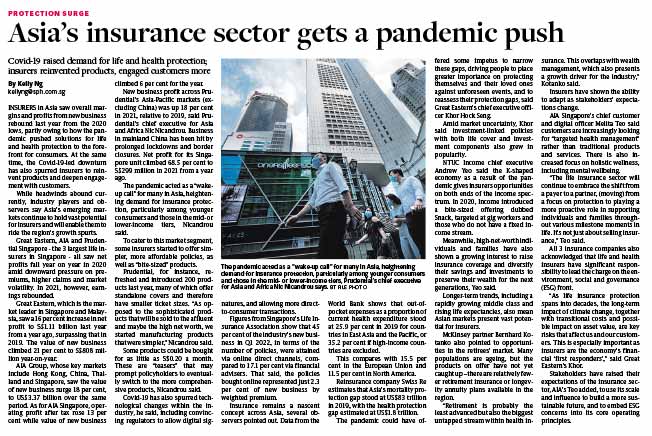Protection surge
Asia’s insurance sector gets a pandemic push
Covid-19 raised demand for life and health protection; insurers reinvented products, engaged customers more

The pandemic acted as a “wake-up call” for many in Asia, heightening demand for insurance protection, particularly among younger consumers and those in the mid- or lower-income tiers, Prudential’s chief executive for Asia and Africa Nic Nicandrou says.
Kelly Ng
kellyng@sph.com.sg
INSURERS in Asia saw overall margins and profits from new business rebound last year from the 2020 lows, partly owing to how the pandemic pushed solutions for life and health protection to the forefront for consumers. At the same time, the Covid-19-led downturn has also spurred insurers to reinvent products and deepen engagement with customers.
While headwinds abound currently, industry players and observers say Asia’s emerging markets continue to hold vast potential for insurers and will enable them to ride the region’s growth spurts.
Great Eastern, AIA and Prudential Singapore - the 3 largest life insurers in Singapore - all saw net profits fall year on year in 2020 amid downward pressure on premiums, higher claims and market volatility. In 2021, however, earnings rebounded.
Great Eastern, which is the market leader in Singapore and Malaysia, saw a 16 per cent increase in net profit to S$1.11 billion last year from a year ago, surpassing that in 2019. The value of new business climbed 21 per cent to S$808 million year-on-year.
AIA Group, whose key markets include Hong Kong, China, Thailand and Singapore, saw the value of new business surge 18 per cent, to US$3.37 billion over the same period. As for AIA Singapore, operating profit after tax rose 13 per cent while value of new business climbed 6 per cent for the year.
New business profit across Prudential’s Asia-Pacific markets (excluding China) was up 18 per cent in 2021, relative to 2019, said Prudential’s chief executive for Asia and Africa Nic Nicandrou. Business in mainland China has been hit by prolonged lockdowns and border closures. Net profit for its Singapore unit climbed 68.5 per cent to S$299 million in 2021 from a year ago.
The pandemic acted as a “wake-up call” for many in Asia, heightening demand for insurance protection, particularly among younger consumers and those in the mid- or lower-income tiers, Nicandrou said.
To cater to this market segment, some insurers started to offer simpler, more affordable policies, as well as “bite-sized” products.
Prudential, for instance, refreshed and introduced 200 products last year, many of which offer standalone covers and therefore have smaller ticket sizes. “As opposed to the sophisticated products that will be sold to the affluent and maybe the high net worth, we started manufacturing products that were simpler,” Nicandrou said.
Some products could be bought for as little as S$0.20 a month. These are “teasers” that may prompt policyholders to eventually switch to the more comprehensive products, Nicandrou said.
Covid-19 has also spurred technological changes within the industry, he said, including convincing regulators to allow digital signatures, and allowing more direct-to-consumer transactions.
Figures from Singapore’s Life Insurance Association show that 45 per cent of the industry’s new business in Q1 2022, in terms of the number of policies, were attained via online direct channels, compared to 17.1 per cent via financial advisers. That said, the policies bought online represented just 2.3 per cent of new business by weighted premium.
Insurance remains a nascent concept across Asia, several observers pointed out. Data from the World Bank shows that out-of-pocket expenses as a proportion of current health expenditure stood at 25.9 per cent in 2019 for countries in East Asia and the Pacific, or 35.2 per cent if high-income countries are excluded.
This compares with 15.5 per cent in the European Union and 11.5 per cent in North America.
Reinsurance company Swiss Re estimates that Asia’s mortality protection gap stood at US$83 trillion in 2019, with the health protection gap estimated at US$1.8 trillion.
The pandemic could have offered some impetus to narrow these gaps, driving people to place greater importance on protecting themselves and their loved ones against unforeseen events, and to reassess their protection gaps, said Great Eastern’s chief executive officer Khor Hock Seng.
Amid market uncertainty, Khor said investment-linked policies with both life cover and investment components also grew in popularity.
NTUC Income chief executive Andrew Yeo said the K-shaped economy as a result of the pandemic gives insurers opportunities on both ends of the income spectrum. In 2020, Income introduced a bite-sized offering dubbed Snack, targeted at gig workers and those who do not have a fixed income stream.
Meanwhile, high-net-worth individuals and families have also shown a growing interest to raise insurance coverage and diversify their savings and investments to preserve their wealth for the next generations, Yeo said.
Longer-term trends, including a rapidly growing middle class and rising life expectancies, also mean Asian markets present vast potential for insurers.
McKinsey partner Bernhard Kotanko also pointed to opportunities in the retirees’ market. Many populations are ageing, but the products on offer have not yet caught up – there are relatively fewer retirement insurance or longevity annuity plans available in the region.
“Retirement is probably the least advanced but also the biggest untapped stream within health insurance. This overlaps with wealth management, which also presents a growth driver for the industry,” Kotanko said.
Insurers have shown the ability to adapt as stakeholders’ expectations change.
AIA Singapore’s chief customer and digital officer Melita Teo said customers are increasingly looking for “targeted health management” rather than traditional products and services. There is also increased focus on holistic wellness, including mental wellbeing.
“The life insurance sector will continue to embrace the shift from a payer to a partner, (moving) from a focus on protection to playing a more proactive role in supporting individuals and families throughout various milestone moments in life. It’s not just about selling insurance,” Teo said.
All 3 insurance companies also acknowledged that life and health insurers have significant responsibility to lead the charge on the environment, social and governance (ESG) front.
“As life insurance protection spans into decades, the long-term impact of climate change, together with transitional costs and possible impact on asset value, are key risks that affect us and our customers. This is especially important as insurers are the economy’s financial ‘first responders’,” said Great Eastern’s Khor.
Stakeholders have raised their expectations of the insurance sector, AIA’s Teo added, to use its scale and influence to build a more sustainable future, and to embed ESG concerns into its core operating principles.
Source: The Business Times © Singapore Press Holdings Limited. Permission required for reproduction.
This article was first published in The Business Times on 17 May 2022.



